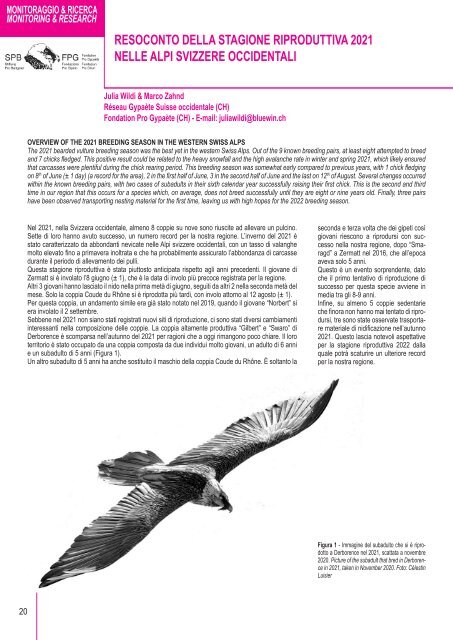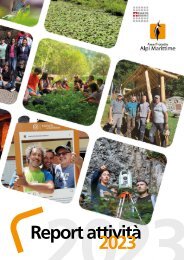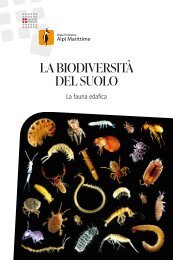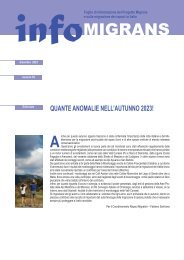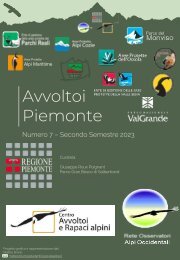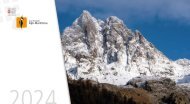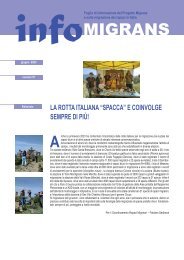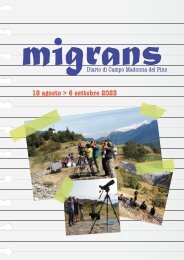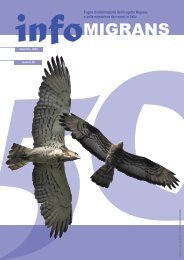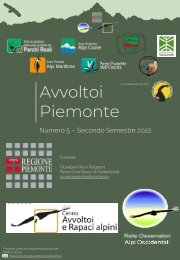infoGIPETO n.38 |dicembre 2021
Periodico d'informazione sul progetto di reintroduzione del gipeto.
Periodico d'informazione sul progetto di reintroduzione del gipeto.
- No tags were found...
Create successful ePaper yourself
Turn your PDF publications into a flip-book with our unique Google optimized e-Paper software.
MONITORAGGIO & RICERCA<br />
MONITORING & RESEARCH<br />
RESOCONTO DELLA STAGIONE RIPRODUTTIVA <strong>2021</strong><br />
NELLE ALPI SVIZZERE OCCIDENTALI<br />
Julia Wildi & Marco Zahnd<br />
Réseau Gypaète Suisse occidentale (CH)<br />
Fondation Pro Gypaète (CH) - E-mail: juliawildi@bluewin.ch<br />
OVERVIEW OF THE <strong>2021</strong> BREEDING SEASON IN THE WESTERN SWISS ALPS<br />
The <strong>2021</strong> bearded vulture breeding season was the best yet in the western Swiss Alps. Out of the 9 known breeding pairs, at least eight attempted to breed<br />
and 7 chicks fledged. This positive result could be related to the heavy snowfall and the high avalanche rate in winter and spring <strong>2021</strong>, which likely ensured<br />
that carcasses were plentiful during the chick rearing period. This breeding season was somewhat early compared to previous years, with 1 chick fledging<br />
on 8 th of June (± 1 day) (a record for the area), 2 in the first half of June, 3 in the second half of June and the last on 12 th of August. Several changes occurred<br />
within the known breeding pairs, with two cases of subadults in their sixth calendar year successfully raising their first chick. This is the second and third<br />
time in our region that this occurs for a species which, on average, does not breed successfully until they are eight or nine years old. Finally, three pairs<br />
have been observed transporting nesting material for the first time, leaving us with high hopes for the 2022 breeding season.<br />
Nel <strong>2021</strong>, nella Svizzera occidentale, almeno 8 coppie su nove sono riuscite ad allevare un pulcino.<br />
Sette di loro hanno avuto successo, un numero record per la nostra regione. L’inverno del <strong>2021</strong> è<br />
stato caratterizzato da abbondanti nevicate nelle Alpi svizzere occidentali, con un tasso di valanghe<br />
molto elevato fino a primavera inoltrata e che ha probabilmente assicurato l’abbondanza di carcasse<br />
durante il periodo di allevamento dei pulli.<br />
Questa stagione riproduttiva è stata piuttosto anticipata rispetto agli anni precedenti. Il giovane di<br />
Zermatt si è involato l’8 giugno (± 1), che è la data di involo più precoce registrata per la regione.<br />
Altri 3 giovani hanno lasciato il nido nella prima metà di giugno, seguiti da altri 2 nella seconda metà del<br />
mese. Solo la coppia Coude du Rhône si è riprodotta più tardi, con involo attorno al 12 agosto (± 1).<br />
Per questa coppia, un andamento simile era già stato notato nel 2019, quando il giovane “Norbert” si<br />
era involato il 2 settembre.<br />
Sebbene nel <strong>2021</strong> non siano stati registrati nuovi siti di riproduzione, ci sono stati diversi cambiamenti<br />
interessanti nella composizione delle coppie. La coppia altamente produttiva “Gilbert” e “Swaro” di<br />
Derborence è scomparsa nell’autunno del <strong>2021</strong> per ragioni che a oggi rimangono poco chiare. Il loro<br />
territorio è stato occupato da una coppia composta da due individui molto giovani, un adulto di 6 anni<br />
e un subadulto di 5 anni (Figura 1).<br />
Un altro subadulto di 5 anni ha anche sostituito il maschio della coppia Coude du Rhône. È soltanto la<br />
seconda e terza volta che dei gipeti così<br />
giovani riescono a riprodursi con successo<br />
nella nostra regione, dopo “Smaragd”<br />
a Zermatt nel 2016, che all’epoca<br />
aveva solo 5 anni.<br />
Questo è un evento sorprendente, dato<br />
che il primo tentativo di riproduzione di<br />
successo per questa specie avviene in<br />
media tra gli 8-9 anni.<br />
Infine, su almeno 5 coppie sedentarie<br />
che finora non hanno mai tentato di riprodursi,<br />
tre sono state osservate trasportare<br />
materiale di nidificazione nell’autunno<br />
<strong>2021</strong>. Questo lascia notevoli aspettative<br />
per la stagione riproduttiva 2022 dalla<br />
quale potrà scaturire un ulteriore record<br />
per la nostra regione.<br />
Figura 1 - Immagine del subadulto che si è riprodotto<br />
a Derborence nel <strong>2021</strong>, scattata a novembre<br />
2020. Picture of the subadult that bred in Derborence<br />
in <strong>2021</strong>, taken in November 2020. Foto: Célestin<br />
Luisier<br />
20


